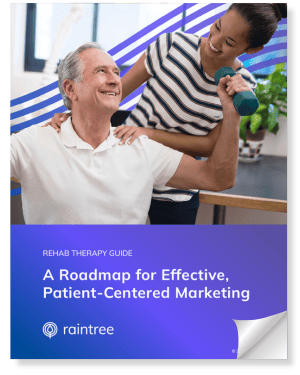If you’re part of a small marketing team at a physical therapy practice, you can start growing your organic website traffic by building on the topics you knows best.
To help get you started, we’re here to share some tips for building your brand with a physical therapy blog!
Starting a Physical Therapy Blog
Starting a blog is a great way to let your audience (current and potential customers) get to know you, build trust as well as engage with your practice! Blogging is also one of the best ways to drive traffic to your website. Here are three things that you should remember:
-
- Establish your brand’s story and core messages
- Understand your audience to provide valuable content
- Provide clear next steps and additional resources
In addition, starting a physical therapy blog can create a solid foundation for distributing content across various platforms. For example, one blog can link to other blogs or website pages as well as include infographics, promote social media and highlight call-to-actions (CTAs) that direct visitors to landing pages with contact forms. And you can repurpose blog post content on other platforms, too!
Branding: Know Yourself
Branding begins with knowing who you are, what you do and why you do it, but what’s most important is ensuring your blog content highlights your organization’s values as well as emphasizes the purpose of your practice’s mission or just cause. In fact, a great way to communicate effectively and consistently is developing a quick writing guide that contains standards such as brand identity, style or tone.
Empathy: Know Your Audience
In order to understand your audience, you should measure both qualitative (non-numerical) and quantitative (numerical) data so that you can properly build buyer personas. These groups or specific characters, whether they are categorized demographically or via other variables, will help you facilitate content that caters directly to them and propel targeted engagement.
For qualitative data, engagement campaigns that feature surveys such as NPS (net promoter score) or TVS (therapy value score) are a great way to monitor satisfaction rates and track outcome trends. You can also send clinical questionnaires or patient forms that can be helpful in navigating customer interests and generating new content ideas.
On the other hand, quantitative data can be pulled from a number of places, but if your practice wants to leverage seamless automation and interactive reporting, you should explore the capabilities of business intelligence (BI) and analytics. However, if you don’t have a BI platform, fear not. There are plenty of marketing tools and platforms that can help you make good use of your data.
💯 Practical Advice
Check out these guides from Hubspot on Blog Strategy and Moz’s Beginner’s Guide to SEO.
Positioning: Know Your Practice's Value
Once you have developed a better understanding of who you’re speaking to and what they need, the final step is to deliver value to them through posts that not only attract attention but also educate your audience. For example, if you are a physical therapy practice that has a light-hearted or playful tone and you find out that your audience or even a specific buyer persona tends to love dogs – you could write a blog post about the uses for therapy animals. Not only would such a post spark their interest and be enjoyable to read, but it would enable them to read more of your content as well as push more traffic to your website.



